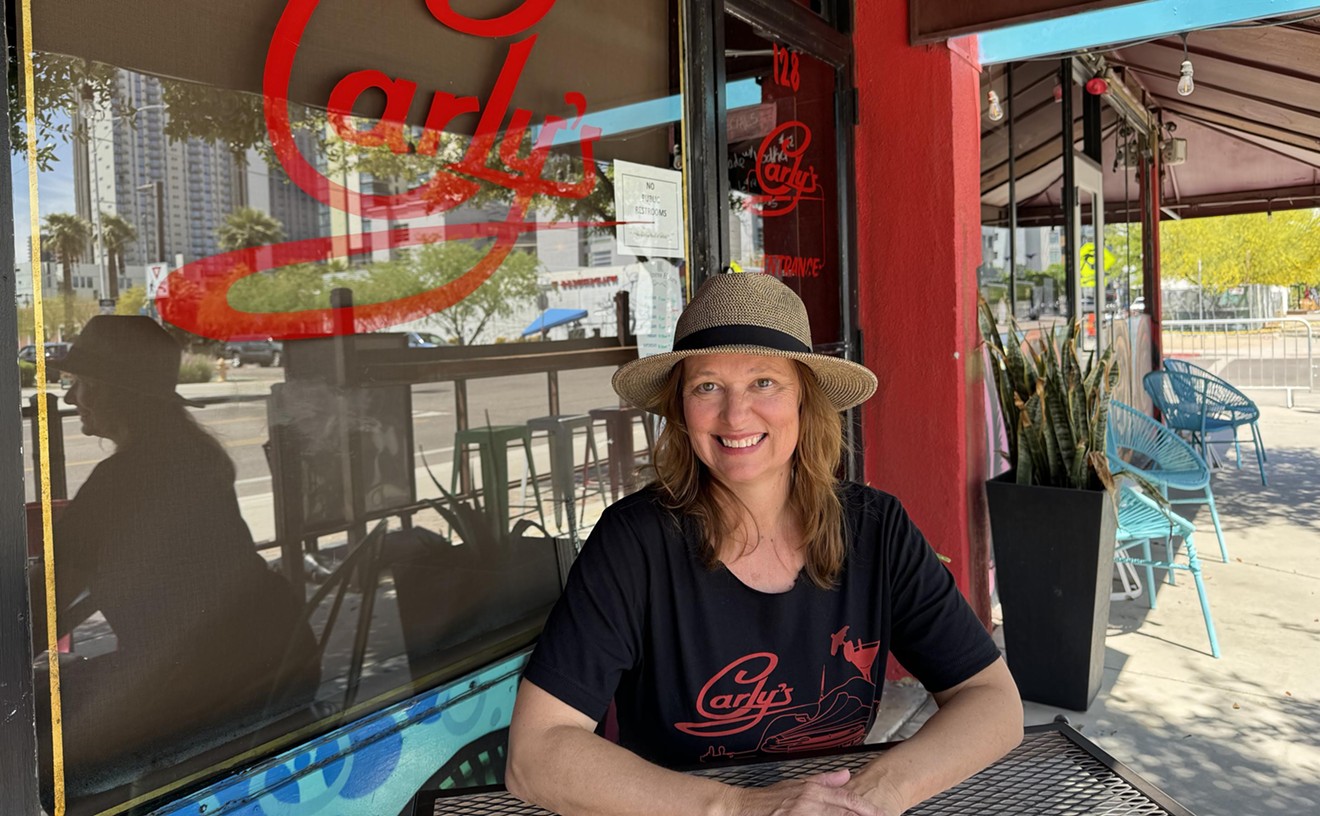Another online dictionary sent back the definition as "juice." Which might be appropriate, because Sugo's other claim to fame is that it's a wine bar, with an impressive list of some 60 labels, the finest of Italy. You can buy a half bottle of Sassicaia 1999, a full-bodied Tuscan Cabernet Sauvignon, for $99 here.
A third attempt, with my trusty Collins Italian Dictionary, delivered "sauce." Which finally made the most sense, because the dictionary also referred me to the traditional recipe for sugo di carne, or what meat sauce is called in Florence, Italy. In this creation, unlike thick, sugary American sauces, classic sugo incorporates a hefty amount of premium ground sirloin tossed simply with finely chopped onion, carrot and celery (a combination called soffritto, a fun fact with which to amaze friends at cocktail parties), red wine, extra virgin olive oil, salt, and just a touch of plum tomatoes.
The chef slowly sautés the soffritto in olive oil until it almost burns (this trick makes it taste like "Mamma," I read, and sweetens the carrots and onions). Then the chef adds the ground sirloin, raises the heat, and stirs until the meat is browned, splashing it with wine. The tomatoes go in, then a dash of salt. The whole brew simmers for as long as the chef and his guests can stand it -- the aroma is intoxicating, and hungry folks can usually hold out for only an hour or two.
The recipe sounded so good, I almost made up a big pot of the stuff right then and there in my own kitchen. Except that I'm so much better at eating out than cooking.
So instead, I went to Sugo, where I fought for a table in the crowded room, then zeroed in on what looked to be the closest rendition of my sought-after sauce: fettuccine alla Bolognese ("with Sugo's meat sauce," as described in the menu).
My definition? Yuck. Call me crazy -- certainly not drunk, though I was thoroughly enjoying a bottle of Pinot Grigio that was so well-priced I was tempted to order more (a simple, citrusy 2001 Cielo for an unpretentious $16) -- but I'd swear the sauce was laced with lemon. Lots and lots of lemon. Four people at my table tasted it -- nobody wanted more than a few forkfuls of the otherwise bland concoction, notable for generous amounts of ground beef and nothing else.
I didn't like any of the pasta that evening, actually. My group ordered penne carciofo because we wanted the artichoke hearts it came with, and while we loved the vegetable, the garlic, white wine, cream and lemon sauce was gluey and dull. We tried the spaghetti aglio e oglio because the stark combination of garlic and extra virgin olive oil can be arresting, but this version was simply greasy. I was tempted by the timballo, compelled by the hearty-sounding character of Bolognese, prosciutto cotto and béchamel sauce. But this dish was simply weird, bringing a mound of dried-out pasta sheets folded around ground beef, tiny bits of ham and spaghetti, baked, then drizzled with trace amounts of thin milk-butter-flour roux. It looked like a white cow pie; it tasted like lemon.
We left, wondering what Sugo was trying to do, and why it was so popular with the patrons constantly flooding in. I found the glowing red lighting irritating, the glittery candles in holders sparkling like disco balls, and the whole an unattractive environment for looking at food. I hated the dance music pounding so loudly my friends and I could barely hear each other. I didn't appreciate that this place so obviously would be converted into a nightclub after diners departed, what with its concrete floors, coffee-shop-style tables, oversize speakers hunkered on the floor, and a complete DJ spinning booth next to the bar. Service was ridiculous, with our waitress obviously flustered and wired up, constantly forgetting our drinks and fumbling over what desserts were offered (and there are only two sweet selections -- a passable panna cotta and a too-complicated mess of fried ravioli filled with chocolate hazelnut and mascarpone in Frangelico sauce). For this, I paid $12 for that atrocious fettuccine Bolognese?
But like my search for the Italian definition of "sugo," I tried the restaurant again. And voilà. A second visit found the dishes transformed -- near-perfect presentations of pasta and sauce. A third visit, and finally Sugo made complete sense. This time, the food was fabulous, so stunning that, yes, I will happily shell out the bigger bucks for a simple Sugo spaghetti, dressed with slips of salty-cured pancetta, sage, white wine, cream and slabs of real, zingy garlic clove. The red lighting still bugs me, but management appears to have shelved the pounding tunes. And on these subsequent evenings, the servers were experts in their wine offerings, guiding us through the flurry and helping us choose the perfect pairing for our capellini gamberi (angel hair with firm, plump shrimp and a gutsy anise-toned sambuca-saffron sauce) or bucatini all'Amatriciana (thickish spaghetti with salty pancetta, onion and tomato sauce).
What changed? Who knows? But who cares, as long as Sugo's staff keeps knocking themselves out in this manner, directing me to off-the-menu delicious bargain bottles of Tramin Sudtirol (Alto Adige) Pinot Grigio, or Rosso Di Montepulciano La Magia 2000. And as long as the kitchen keeps sending out such spectacular successes as capellini giardino, angel hair spiked with crisp fresh peas, tangy roasted red peppers, mushrooms, lots of fresh sliced garlic and herbs in a velvety cream-tomato sauce. The sauce makes the penne all puttanesca, too, wet and luxurious with ripe tomato, bitterish capers, salt-kissed anchovies and tart pitted Kalamata olives. Whatever occurred in the kitchen after that first failure, the chef now pulls out the stops with a charming penne salsiccia, thick with spicy fennel sausage crumbles, fire-roasted peppers and a confident roasted garlic cream sauce.
Sugo comes from talented owners, Maurizio and Sandra Cristiani, proprietors of Grazie, a gourmet pizza-wine bar across the street. They've brought over many of their successful appetizers, like a piatto misto, layered with curls of salami, ham, capocollo, chunks of Parmigiano-Reggiano and Kalamata olives to be nibbled with skinny breadsticks, crusty bread and a tomato-olive spread. Bruschetta is a combination of basil and tomato atop grilled bread, paired with crostinis of marinated mushrooms and tapenade.
Carpaccio bresaola (dry-cured, leaf-thin beef) comes tossed with arugula and Parmigiano-Reggiano in lemon vinaigrette and is excellent, but the best starter plate is scampi. These shrimp are first-rate, nested on crunchy toast rafts on a pool of rich garlic butter.
À la Grazie, Sugo's salads are entree-size, and my table finds one ample to feed four. We like the caesar, tears of fresh crunchy romaine in a thick, creamy dressing with lots of finely grated Parmesan; we like the Emiliana salad, a brightly colored mound of arugula, baby greens, Parmigiano-Reggiano, red onions, red bell peppers and pine nuts in a pleasingly sharp balsamic vinaigrette. But we adore the insalata della casa, a beautiful garden of baby greens, tomato slabs, cucumbers, Kalamata olives and roasted peppers in sparkling Italian vinaigrette or silky Gorgonzola cheese dressing. It's fresh, light, exciting and summery.
Sugo may have started out so-so, but is only getting better, on its way to brilliant. If the chef decides to test the sugo de carne recipe I crave, I'm hoping he'll let me know. My final definition? Sugo is sensational. So go.










